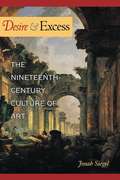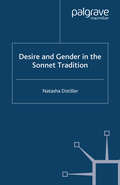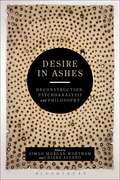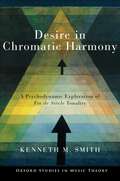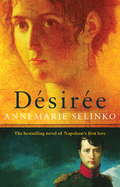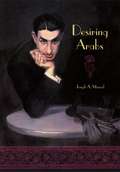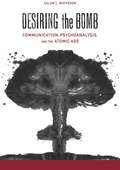- Table View
- List View
Desire and Empathy in Twentieth-Century Dystopian Fiction (Palgrave Studies In Utopianism Ser.)
by Thomas HoranThis book assesses key works of twentieth-century dystopian fiction, including Katharine Burdekin’s Swastika Night, George Orwell’s Nineteen Eighty-Four, and Margaret Atwood’s The Handmaid’s Tale, to demonstrate that the major authors of this genre locate empathy and morality in eroticism. Taken together, these books delineate a subset of politically conscious speculative literature, which can be understood collectively as projected political fiction. While Thomas Horan addresses problematic aspects of this subgenre, particularly sexist and racist stereotypes, he also highlights how some of these texts locate social responsibility in queer and other non-heteronormative sexual relationships. In these novels, even when the illicit relationship itself is truncated, sexual desire fosters hope and community.
Desire and Empathy in Twentieth-Century Dystopian Fiction
by Thomas HoranThis book assesses key works of twentieth-century dystopian fiction, including Katharine Burdekin’s Swastika Night, George Orwell’s Nineteen Eighty-Four, and Margaret Atwood’s The Handmaid’s Tale, to demonstrate that the major authors of this genre locate empathy and morality in eroticism. Taken together, these books delineate a subset of politically conscious speculative literature, which can be understood collectively as projected political fiction. While Thomas Horan addresses problematic aspects of this subgenre, particularly sexist and racist stereotypes, he also highlights how some of these texts locate social responsibility in queer and other non-heteronormative sexual relationships. In these novels, even when the illicit relationship itself is truncated, sexual desire fosters hope and community.
Desire and Excess: The Nineteenth-Century Culture of Art (PDF)
by Jonah SiegelIn this fascinating look at the creative power of institutions, Jonah Siegel explores the rise of the modern idea of the artist in the nineteenth century, a period that also witnessed the emergence of the museum and the professional critic. Treating these developments as interrelated, he analyzes both visual material and literary texts to portray a culture in which art came to be thought of in powerful new ways. Ultimately, Siegel shows that artistic controversies commonly associated with the self-consciously radical movements of modernism and postmodernism have their roots in a dynamic era unfairly characterized as staid, self-satisfied, and stable.The nineteenth century has been called the Age of the Museum, and yet critics, art theorists, and poets during this period grappled with the question of whether the proliferation of museums might lead to the death of Art itself. Did the assembly and display of works of art help the viewer to understand them or did it numb the senses? How was the contemporary artist to respond to the vast storehouses of art from disparate nations and periods that came to proliferate in this era?Siegel presents a lively discussion of the shock experienced by neoclassical artists troubled by remains of antiquity that were trivial or even obscene, as well as the anxious aesthetic reveries of nineteenth-century art lovers overwhelmed by the quantity of objects quickly crowding museums and exhibition halls. In so doing, he illuminates the fruitful crises provoked when the longing for admired art is suddenly satisfied. Drawing upon neoclassical art and theory, biographies of early nineteenth-century writers including Keats and Scott, and the writings of art critics such as Hazlitt, Ruskin, and Wilde, this book reproduces a cultural matrix that brings to life the artistic passions and anxieties of an entire era.
Desire and Excess: The Nineteenth-Century Culture of Art
by Jonah SiegelIn this fascinating look at the creative power of institutions, Jonah Siegel explores the rise of the modern idea of the artist in the nineteenth century, a period that also witnessed the emergence of the museum and the professional critic. Treating these developments as interrelated, he analyzes both visual material and literary texts to portray a culture in which art came to be thought of in powerful new ways. Ultimately, Siegel shows that artistic controversies commonly associated with the self-consciously radical movements of modernism and postmodernism have their roots in a dynamic era unfairly characterized as staid, self-satisfied, and stable.The nineteenth century has been called the Age of the Museum, and yet critics, art theorists, and poets during this period grappled with the question of whether the proliferation of museums might lead to the death of Art itself. Did the assembly and display of works of art help the viewer to understand them or did it numb the senses? How was the contemporary artist to respond to the vast storehouses of art from disparate nations and periods that came to proliferate in this era?Siegel presents a lively discussion of the shock experienced by neoclassical artists troubled by remains of antiquity that were trivial or even obscene, as well as the anxious aesthetic reveries of nineteenth-century art lovers overwhelmed by the quantity of objects quickly crowding museums and exhibition halls. In so doing, he illuminates the fruitful crises provoked when the longing for admired art is suddenly satisfied. Drawing upon neoclassical art and theory, biographies of early nineteenth-century writers including Keats and Scott, and the writings of art critics such as Hazlitt, Ruskin, and Wilde, this book reproduces a cultural matrix that brings to life the artistic passions and anxieties of an entire era.
Desire and Gender in the Sonnet Tradition
by N. DistillerThis new study explores the poetic tradition of the love sonnet sequence in English as written by women from 1621-1931. It connects this tradition to ways of speaking desire in public in operation today, and to the development of theories of subjectivity in Western culture.
The Desire for Mutual Recognition: Social Movements and the Dissolution of the False Self
by Peter GabelThe Desire for Mutual Recognition is a work of accessible social theory that seeks to make visible the desire for authentic social connection, emanating from our social nature, that animates all human relationships. Using a social-phenomenological method that illuminates rather than explains social life, Peter Gabel shows how the legacy of social alienation that we have inherited from prior generations envelops us in a milieu of a "fear of the other," a fear of each other. Yet because social reality is always co-constituted by the desire for authentic connection and genuine co-presence, social transformation always remains possible, and liberatory social movements are always emerging and providing us with a permanent source of hope. The great progressive social movements for workers' rights, civil rights, and women’s and gay liberation, generated their transformative power from their capacity to transcend the reciprocal isolation that otherwise separates us. These movements at their best actually realize our fundamental longing for mutual recognition, and for that very reason they can generate immense social change and bend the moral arc of the universe toward justice. Gabel examines the struggle between desire and alienation as it unfolds across our social world, calling for a new social-spiritual activism that can go beyond the limitations of existing progressive theory and action, intentionally foster and sustain our capacity to heal what separates us, and inspire a new kind of social movement that can transform the world.
The Desire for Mutual Recognition: Social Movements and the Dissolution of the False Self
by Peter GabelThe Desire for Mutual Recognition is a work of accessible social theory that seeks to make visible the desire for authentic social connection, emanating from our social nature, that animates all human relationships. Using a social-phenomenological method that illuminates rather than explains social life, Peter Gabel shows how the legacy of social alienation that we have inherited from prior generations envelops us in a milieu of a "fear of the other," a fear of each other. Yet because social reality is always co-constituted by the desire for authentic connection and genuine co-presence, social transformation always remains possible, and liberatory social movements are always emerging and providing us with a permanent source of hope. The great progressive social movements for workers' rights, civil rights, and women’s and gay liberation, generated their transformative power from their capacity to transcend the reciprocal isolation that otherwise separates us. These movements at their best actually realize our fundamental longing for mutual recognition, and for that very reason they can generate immense social change and bend the moral arc of the universe toward justice. Gabel examines the struggle between desire and alienation as it unfolds across our social world, calling for a new social-spiritual activism that can go beyond the limitations of existing progressive theory and action, intentionally foster and sustain our capacity to heal what separates us, and inspire a new kind of social movement that can transform the world.
Desire in Ashes: Deconstruction, Psychoanalysis, Philosophy (Bloomsbury Studies in Continental Philosophy)
by Simon Wortham Chiara AlfanoThe indebtedness of contemporary thinkers to Derrida's project of deconstruction is unquestionable, whether as a source of inspiration or the grounds of critical antagonism. This collection considers: how best to recall deconstruction? Rather than reduce it to an object of historical importance or memory, these essays analyze its significance in terms of complex matrices of desire; provoked in this way, deconstruction cannot be dismissed as 'dead', nor unproblematically defended as alive and well.Repositioned on the threshold of life-death, deconstruction profoundly complicates the field of critical thought which still struggles to memorialize, inter, or reduce the deconstructive corpus to ashes.
Desire in Ashes: Deconstruction, Psychoanalysis, Philosophy (Bloomsbury Studies in Continental Philosophy)
by Simon Morgan Wortham Chiara AlfanoThe indebtedness of contemporary thinkers to Derrida's project of deconstruction is unquestionable, whether as a source of inspiration or the grounds of critical antagonism. This collection considers: how best to recall deconstruction? Rather than reduce it to an object of historical importance or memory, these essays analyze its significance in terms of complex matrices of desire; provoked in this way, deconstruction cannot be dismissed as 'dead', nor unproblematically defended as alive and well.Repositioned on the threshold of life-death, deconstruction profoundly complicates the field of critical thought which still struggles to memorialize, inter, or reduce the deconstructive corpus to ashes.
Desire in Chromatic Harmony: A Psychodynamic Exploration of Fin de Siècle Tonality (Oxford Studies in Music Theory)
by Kenneth M. SmithHow does musical harmony engage listeners in relations of desire? Where does this desire come from? Author Kenneth Smith seeks to answer these questions by analyzing works from the turn of the twentieth- century that are both harmonically enriched and psychologically complex. Desire in Chromatic Harmony yields a new theory of how chromatic chord progressions direct the listener on intricate journeys through harmonic space, mirroring the tensions of the psyche found in Schopenhauer, Freud, Lacan, Lyotard, and Deleuze. Smith extends this mode of enquiry into sophisticated music theory, while exploring philosophically engaged European and American composers such as Richard Strauss, Alexander Skryabin, Josef Suk, Charles Ives, and Aaron Copland. Focusing on harmony and chord progression, the book drills down into the diatonic undercurrent beneath densely chromatic and dissonant surfaces. From the obsession with death and mourning in Suk's asrael Symphony to an exploration of "perversion" in Strauss's elektra; from the Sufi mysticism of Szymanowski's Song of the Night to the failed fantasy of the American dream in Copland's The Tender Land, Desire in Chromatic Harmony cuts a path through the dense forests of chromatic complexity, revealing the psychological make-up of post-Wagnerian psychodynamic music.
Desire in Chromatic Harmony: A Psychodynamic Exploration of Fin de Siècle Tonality (Oxford Studies in Music Theory)
by Kenneth M. SmithHow does musical harmony engage listeners in relations of desire? Where does this desire come from? Author Kenneth Smith seeks to answer these questions by analyzing works from the turn of the twentieth- century that are both harmonically enriched and psychologically complex. Desire in Chromatic Harmony yields a new theory of how chromatic chord progressions direct the listener on intricate journeys through harmonic space, mirroring the tensions of the psyche found in Schopenhauer, Freud, Lacan, Lyotard, and Deleuze. Smith extends this mode of enquiry into sophisticated music theory, while exploring philosophically engaged European and American composers such as Richard Strauss, Alexander Skryabin, Josef Suk, Charles Ives, and Aaron Copland. Focusing on harmony and chord progression, the book drills down into the diatonic undercurrent beneath densely chromatic and dissonant surfaces. From the obsession with death and mourning in Suk's asrael Symphony to an exploration of "perversion" in Strauss's elektra; from the Sufi mysticism of Szymanowski's Song of the Night to the failed fantasy of the American dream in Copland's The Tender Land, Desire in Chromatic Harmony cuts a path through the dense forests of chromatic complexity, revealing the psychological make-up of post-Wagnerian psychodynamic music.
Desire in the Iliad: The Force That Moves the Epic and Its Audience
by Rachel H. LesserThis is the first study to examine desire in the Iliad in a comprehensive way, and to explain its relationship to the epic's narrative structure and audience reception. Rachel H. Lesser offers a new reading of the poem that shows how the characters' desires, especially those of the mortal hero Achilleus and the divine king Zeus, motivate plot and keep the audience engaged with the epic until and even beyond its end. The author argues that the characters' desires are primarily organized in narrative triangles that feature two parties in conflict over a third. A variety of desires animate these triangles, including sexual passion, longing for a lost loved one, yearning for lamentation, and aggressive desires for vengeance and status, and they are signified with terms such as eros, himeros, pothe, menos, thumos, boule, and eeldor, as well as through the epic's thematic emotions of grief and anger. Desire in the Iliad shows how the mortals' and gods' triangular desires together drive and shape two Iliadic plots, the main plot of Achilleus' withdrawal from the fighting and then return to battle, and the "superplot" of the larger Trojan War story. The author also argues that these plots and their motivating desires arouse the listener's-or reader's-own corresponding desires: narrative desire to know and understand the Iliad's full story, sympathetic desire for characters' welfare, and empathetic passions, longings, and wishes. Our desires invest us in the epic narrative and their resolution brings us satisfaction.
Desire in the Iliad: The Force That Moves the Epic and Its Audience
by Rachel H. LesserThis is the first study to examine desire in the Iliad in a comprehensive way, and to explain its relationship to the epic's narrative structure and audience reception. Rachel H. Lesser offers a new reading of the poem that shows how the characters' desires, especially those of the mortal hero Achilleus and the divine king Zeus, motivate plot and keep the audience engaged with the epic until and even beyond its end. The author argues that the characters' desires are primarily organized in narrative triangles that feature two parties in conflict over a third. A variety of desires animate these triangles, including sexual passion, longing for a lost loved one, yearning for lamentation, and aggressive desires for vengeance and status, and they are signified with terms such as eros, himeros, pothe, menos, thumos, boule, and eeldor, as well as through the epic's thematic emotions of grief and anger. Desire in the Iliad shows how the mortals' and gods' triangular desires together drive and shape two Iliadic plots, the main plot of Achilleus' withdrawal from the fighting and then return to battle, and the "superplot" of the larger Trojan War story. The author also argues that these plots and their motivating desires arouse the listener's-or reader's-own corresponding desires: narrative desire to know and understand the Iliad's full story, sympathetic desire for characters' welfare, and empathetic passions, longings, and wishes. Our desires invest us in the epic narrative and their resolution brings us satisfaction.
Desire Lines: A Scottish Odyssey - A Journey Through Her History
by David R RossDavid R. Ross not only shows us his Scotland but he teaches us it too. You feel as though you are on the back of his motorcycle listening to the stories of his land as you fly with him up and down the smaller roads, the 'desire lines', of Scotland. Ross takes us off the beaten track and away from the main routes chosen for us by modern road builders. He starts our journey in England and criss-crosses the border telling the bloody tales of the towns and villages. His recounting of Scottish history, its myths and its legends is unapologetically and unashamedly pro-Scots.
Desiree: The most popular historical romance since GONE WITH THE WIND (Novela Historica Ser.)
by Annemarie SelinkoThe bestselling novel about Napoleon's first loveOne of the most successful historical romances since GONE WITH THE WINDOver 20 million copies sold worldwideTo be young, in France, and in love: fourteen year old Desiree can't believe her good fortune. Her fiance, a dashing and ambitious Napoleon Bonaparte, is poised for battlefield success, and no longer will she be just a French merchant's daughter. She could not have known the twisting path her role in history would take, nearly breaking her vibrant heart but sweeping her to a life rich in passion and desire.A love story, but so much more, Désirée explores the landscape of a young heart torn in two, giving readers a compelling true story of an ordinary girl whose unlikely brush with history leads to a throne no one would have expected.An epic bestseller that has earned both critical acclaim and mass adoration, Désirée is at once a novel of the rise and fall of empires, the blush and fade of love, and the heart and soul of a woman.
Desires for Reality: Radicalism and Revolution in Western European Film
by Benjamin HalliganAs with many aspects of European cultural life, film was galvanized and transformed by the revolutionary fervor of 1968. This groundbreaking study provides a full account of the era’s cinematic crises, innovations, and provocations, as well as the social and aesthetic contexts in which they appeared. The author mounts a genuinely fresh analysis of a contested period in which everything from the avant-garde experiments of Godard, Pasolini, Schroeter, and Fassbinder to the “low” cinematic genres of horror, pornography, and the Western reflected the cultural upheaval of youth in revolt—a cinema for the barricades.
Desires of Credit in Early Modern Theory and Drama: Commerce, Poesy, and the Profitable Imagination (Studies in Performance and Early Modern Drama)
by Brian SheerinDesires of Credit in Early Modern Theory and Drama traces the near-simultaneous rise of economic theory, literary criticism, and public theater in London at the turn of the seventeenth century, and posits that connecting all three is a fascination with creating something out of nothing simply by acting as if it were there. Author Brian Sheerin contends that the motivating force behind both literary and economic inquiry at this time was the same basic quandary about the human imagination--specifically, how investments of belief can produce tangible consequences. Just as speculators were realizing the potency of collective imagination on economic circulation, readers and dramatists were becoming newly introspective about whether or not the 'lies' of literature could actually be morally 'profitable.' Could one actually benefit by taking certain fictions 'seriously'? Each of the five chapters examines a different dimension of this question by highlighting a particular dramatization of economic trust on the Renaissance stage, in plays by Marlowe, Shakespeare, Heywood, Dekker, and Jonson. The book fills a gap in current scholarship by keeping economic and dramatic interests rigorously grounded in early modern literary criticism, but also by emphasizing the productive nature of debt in a way that resonates with recent economic sociology.
Desires of Credit in Early Modern Theory and Drama: Commerce, Poesy, and the Profitable Imagination (Studies in Performance and Early Modern Drama)
by Brian SheerinDesires of Credit in Early Modern Theory and Drama traces the near-simultaneous rise of economic theory, literary criticism, and public theater in London at the turn of the seventeenth century, and posits that connecting all three is a fascination with creating something out of nothing simply by acting as if it were there. Author Brian Sheerin contends that the motivating force behind both literary and economic inquiry at this time was the same basic quandary about the human imagination--specifically, how investments of belief can produce tangible consequences. Just as speculators were realizing the potency of collective imagination on economic circulation, readers and dramatists were becoming newly introspective about whether or not the 'lies' of literature could actually be morally 'profitable.' Could one actually benefit by taking certain fictions 'seriously'? Each of the five chapters examines a different dimension of this question by highlighting a particular dramatization of economic trust on the Renaissance stage, in plays by Marlowe, Shakespeare, Heywood, Dekker, and Jonson. The book fills a gap in current scholarship by keeping economic and dramatic interests rigorously grounded in early modern literary criticism, but also by emphasizing the productive nature of debt in a way that resonates with recent economic sociology.
Desiring Arabs
by Joseph A. MassadSexual desire has long played a key role in Western judgments about the value of Arab civilization. In the past, Westerners viewed the Arab world as licentious, and Western intolerance of sex led them to brand Arabs as decadent; but as Western society became more sexually open, the supposedly prudish Arabs soon became viewed as backward. Rather than focusing exclusively on how these views developed in the West, in Desiring Arabs Joseph A. Massad reveals the history of how Arabs represented their own sexual desires. To this aim, he assembles a massive and diverse compendium of Arabic writing from the nineteenth century to the present in order to chart the changes in Arab sexual attitudes and their links to Arab notions of cultural heritage and civilization. A work of impressive scope and erudition, Massad’s chronicle of both the history and modern permutations of the debate over representations of sexual desires and practices in the Arab world is a crucial addition to our understanding of a frequently oversimplified and vilified culture. “A pioneering work on a very timely yet frustratingly neglected topic. . . . I know of no other study that can even begin to compare with the detail and scope of [this] work.”—Khaled El-Rouayheb, Middle East Report “In Desiring Arabs, [Edward] Said’s disciple Joseph A. Massad corroborates his mentor’s thesis that orientalist writing was racist and dehumanizing. . . . [Massad] brilliantly goes on to trace the legacy of this racist, internalized, orientalist discourse up to the present.”—Financial Times
Desiring Arabs
by Joseph A. MassadSexual desire has long played a key role in Western judgments about the value of Arab civilization. In the past, Westerners viewed the Arab world as licentious, and Western intolerance of sex led them to brand Arabs as decadent; but as Western society became more sexually open, the supposedly prudish Arabs soon became viewed as backward. Rather than focusing exclusively on how these views developed in the West, in Desiring Arabs Joseph A. Massad reveals the history of how Arabs represented their own sexual desires. To this aim, he assembles a massive and diverse compendium of Arabic writing from the nineteenth century to the present in order to chart the changes in Arab sexual attitudes and their links to Arab notions of cultural heritage and civilization. A work of impressive scope and erudition, Massad’s chronicle of both the history and modern permutations of the debate over representations of sexual desires and practices in the Arab world is a crucial addition to our understanding of a frequently oversimplified and vilified culture. “A pioneering work on a very timely yet frustratingly neglected topic. . . . I know of no other study that can even begin to compare with the detail and scope of [this] work.”—Khaled El-Rouayheb, Middle East Report “In Desiring Arabs, [Edward] Said’s disciple Joseph A. Massad corroborates his mentor’s thesis that orientalist writing was racist and dehumanizing. . . . [Massad] brilliantly goes on to trace the legacy of this racist, internalized, orientalist discourse up to the present.”—Financial Times
Desiring Arabs
by Joseph A. MassadSexual desire has long played a key role in Western judgments about the value of Arab civilization. In the past, Westerners viewed the Arab world as licentious, and Western intolerance of sex led them to brand Arabs as decadent; but as Western society became more sexually open, the supposedly prudish Arabs soon became viewed as backward. Rather than focusing exclusively on how these views developed in the West, in Desiring Arabs Joseph A. Massad reveals the history of how Arabs represented their own sexual desires. To this aim, he assembles a massive and diverse compendium of Arabic writing from the nineteenth century to the present in order to chart the changes in Arab sexual attitudes and their links to Arab notions of cultural heritage and civilization. A work of impressive scope and erudition, Massad’s chronicle of both the history and modern permutations of the debate over representations of sexual desires and practices in the Arab world is a crucial addition to our understanding of a frequently oversimplified and vilified culture. “A pioneering work on a very timely yet frustratingly neglected topic. . . . I know of no other study that can even begin to compare with the detail and scope of [this] work.”—Khaled El-Rouayheb, Middle East Report “In Desiring Arabs, [Edward] Said’s disciple Joseph A. Massad corroborates his mentor’s thesis that orientalist writing was racist and dehumanizing. . . . [Massad] brilliantly goes on to trace the legacy of this racist, internalized, orientalist discourse up to the present.”—Financial Times
Desiring The Bomb: Communication, Psychoanalysis, and the Atomic Age (PDF) (Albma Rhetoric Cult And Soc Crit Ser.)
by Calum Lister MathesonA timely interdisciplinary study that applies psychoanalysis and the rhetorical tradition of the sublime to examine the cultural aftermath of the Atomic Age. Every culture throughout history has obsessed over various "end of the world" scenarios. The dawn of the Atomic Age marked a new twist in this tale. For the first time, our species became aware of its capacity to deliberately destroy itself. Since that time the Bomb has served as an organizing metaphor, a symbol of human annihilation, a stand-in for the unspeakable void of extinction, and a discursive construct that challenges the limits of communication itself. The parallel fascination with and abhorrence of nuclear weapons has metastasized into a host of other end-of-the-world scenarios, from global pandemics and climate change to zombie uprisings and asteroid collisions. Desiring the Bomb: Communication, Psychoanalysis, and the Atomic Age explores these world-ending fantasies through the lens of psychoanalysis to reveal their implications for both contemporary apocalyptic culture and the operations of language itself. What accounts for the enduring power of the Bomb as a symbol? What does the prospect of annihilation suggest about language and its limits? Thoroughly researched and accessibly written, this study expands on the theories of Kenneth Burke, Jacques Lacan, Sigmund Freud, and many others from a variety of disciplines to arrive at some answers to these questions. Calum L. Matheson undertakes a series of case studies-including the Trinity test site, nuclear war games, urban shelter schemes, and contemporary survivalism-and argues that contending with the anxieties (individual, social, cultural, and political) born of the Atomic Age depends on rhetorical conceptions of the "real," an order of experience that cannot be easily negotiated in language. Using aspects of media studies, rhetorical theory, and psychoanalysis, the author deftly engages the topics of Atomic Age survival, extinction, religion, and fantasy, along with their enduring cultural legacies, to develop an account of the Bomb as a signifier and to explore why some Americans have become fascinated with fantasies of nuclear warfare and narratives of postapocalyptic rebirth.
Desiring Conversion: Hermas, Thecla, Aseneth
by B. Diane LipsettSelf-restraint or self-mastery may appear to be the opposite of erotic desire. But in this nuanced, literary analysis, Diane Lipsett traces the intriguing interplay of desire and self-restraint in three ancient tales of conversion: The Shepherd of Hermas, the Acts of Paul and Thecla, and Joseph and Aseneth. Lipsett treats "conversion"--marked change in a protagonist's piety and identity--as in part an effect of story, a function of narrative textures, coherence, and closure. Her approach is theoretically versatile, drawing on Foucault, psychoanalytic theorists, and the ancient literary critic Longinus. Well grounded in scholarship on Hermas, Thecla, and Aseneth, the closely paced readings sharpen attention to each story, while advancing discussions of ancient views of the self; of desire, masculinity, and virginity; of the cultural codes around marriage and continence; and of the textual energetics of conversion tales.
Desiring Conversion: Hermas, Thecla, Aseneth
by B. Diane LipsettSelf-restraint or self-mastery may appear to be the opposite of erotic desire. But in this nuanced, literary analysis, Diane Lipsett traces the intriguing interplay of desire and self-restraint in three ancient tales of conversion: The Shepherd of Hermas, the Acts of Paul and Thecla, and Joseph and Aseneth. Lipsett treats ?conversion?--marked change in a protagonist's piety and identity--as in part an effect of story, a function of narrative textures, coherence, and closure. Her approach is theoretically versatile, drawing on Foucault, psychoanalytic theorists, and the ancient literary critic Longinus. Well grounded in scholarship on Hermas, Thecla, and Aseneth, the closely paced readings sharpen attention to each story, while advancing discussions of ancient views of the self; of desire, masculinity, and virginity; of the cultural codes around marriage and continence; and of the textual energetics of conversion tales.

